
The ultimate marketing technology stack
Creating a martech stack that helps you to deliver real business impact is no small feat. With thousands of options to choose from, how do you pick the marketing technology that’s right for your business?
You might be familiar with Scott Brinker’s famous marketing technology (martech) landscape slide. Known as the Martech 5000 – nicknamed after the 5,000 companies that were competing in the global marketing technology space in 2017 – it’s said to be the most frequently shared slide of all time.
By 2020, Brinker had added more than 2,000 vendors – that’s over 7,000 marketing software companies fighting for the same buyers’ attention in a $121 billion dollar industry. He revisited his landscape research in 2021 and confirmed it is indeed not shrinking. One thing is clear: this market is HUGE.
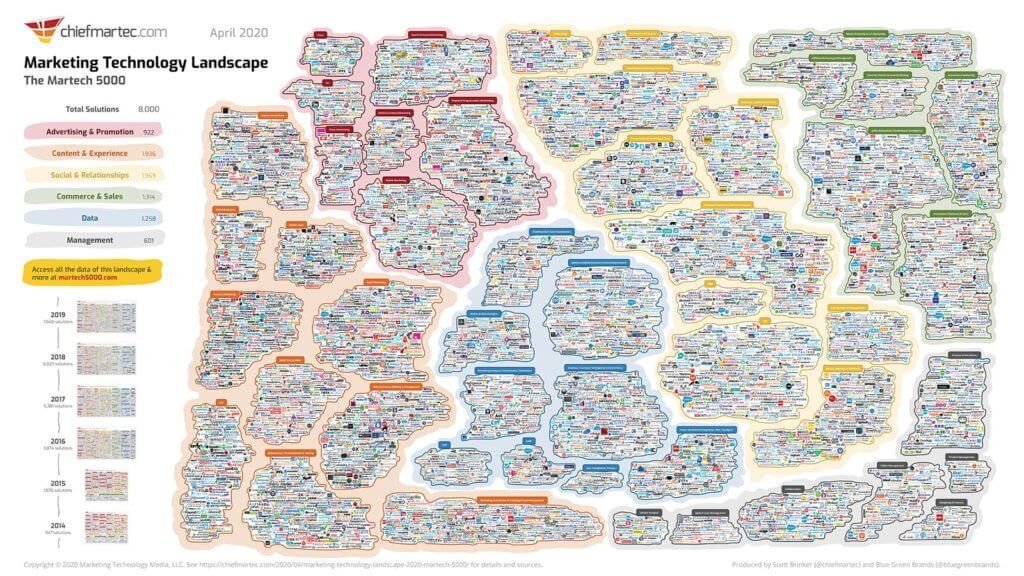
Despite optimism from marketers that spending would bounce back in 2021, marketing budgets dropped to 6.4% of overall company revenue. That’s down from 11% in 2020. Thanks to the impact of the COVID-19 pandemic, marketers are under more pressure than ever to get more bang for their buck, and that means they’re looking for tools that have a big return on investment (ROI) attached to an acceptable price tag.
These days, teams want a simplified, integrated martech stack so they’re not wasting time jumping between tools or manually transferring information from one place to another. This not only saves time and makes marketers more efficient, it reduces the amount of budget required for effective campaigns.
Customer expectations are also higher than ever before. As digital offerings across industries become more sophisticated, consumers want their interactions with brands to be seamless, customized, and engaging (that’s not too much to ask for, is it?). To meet people where they are, and build meaningful relationships at each stage of the customer journey, marketers need an integrated marketing technology stack with tools that foster personalized engagement.
“These modern martech stacks are empowering marketers to do more with less, which is ideal for teams that are trying to boost efficiency and business resilience”
A new wave of low-code and no-code marketing technology is making it easier for marketers to own the tools they work with – without having to be coding experts or rely on outside agencies to make things work. These modern martech stacks are empowering marketers to do more with less, which is ideal for teams that are trying to boost efficiency and business resilience.
We wanted to know how businesses were defining and redefining their marketing tech stacks and using marketing technology to help them reach their goals. With that in mind, we chatted with leaders from some of the fastest-growing software companies – including Hubspot, Clearbit, Aircall, Heap, and more – to get a sense of their vision for the year ahead, which areas they’re investing in the most, and their tips for creating a winning martech stack. (Hint: marketing tech stacks are getting smarter, sleeker, and infinitely more streamlined.)
We’ll also show you how your business can navigate the marketing technology landscape to build a flexible, productive marketing tech stack that can help scale your business this year and beyond. Take a look.
What is a marketing technology stack?
A marketing technology (or martech) stack is the collection of technologies that marketers use to optimize and augment their marketing processes throughout the customer lifecycle. Marketing technologies are used to streamline internal collaboration, analyze the performance of marketing campaigns, and conduct personalized and proactive communication with customers.
Building a smarter martech stack
Before we dive into how to strategize and design your martech stack, we chatted with some of the most innovative, fastest-growing companies in software to understand how they’re planning their martech stacks. The most notable finding? Companies are thinking about how they can optimize their existing martech stacks to attract and engage customers in increasingly personal ways, while optimizing their workflow and the time spent on each task.
Instead of the “shiny penny” approach where marketing leaders are trying out every new tool that emerges on the market, businesses are focused on exploring new ways to capitalize on their current technological capabilities.
This shift comes as no surprise in the current economic climate, but martech underutilization has long been a sticking point for marketers. According to a 2020 Gartner Marketing Technology Survey, marketing leaders reported leveraging only 58% of their martech stack’s potential last year – a figure that’s flatlined since 2019. This underutilization represents a timely opportunity for marketers to realize the benefits of a streamlined martech stack while working within constrained budgets.
#1. Streamline your martech stack
This year, marketing leaders want to get more value from their existing martech stack for less. Yet, most companies don’t have a cohesive plan to fulfill this goal, and 32% of CMOs say they don’t have a strategy for managing their martech stack, with new tools being added on a case-by-case basis.
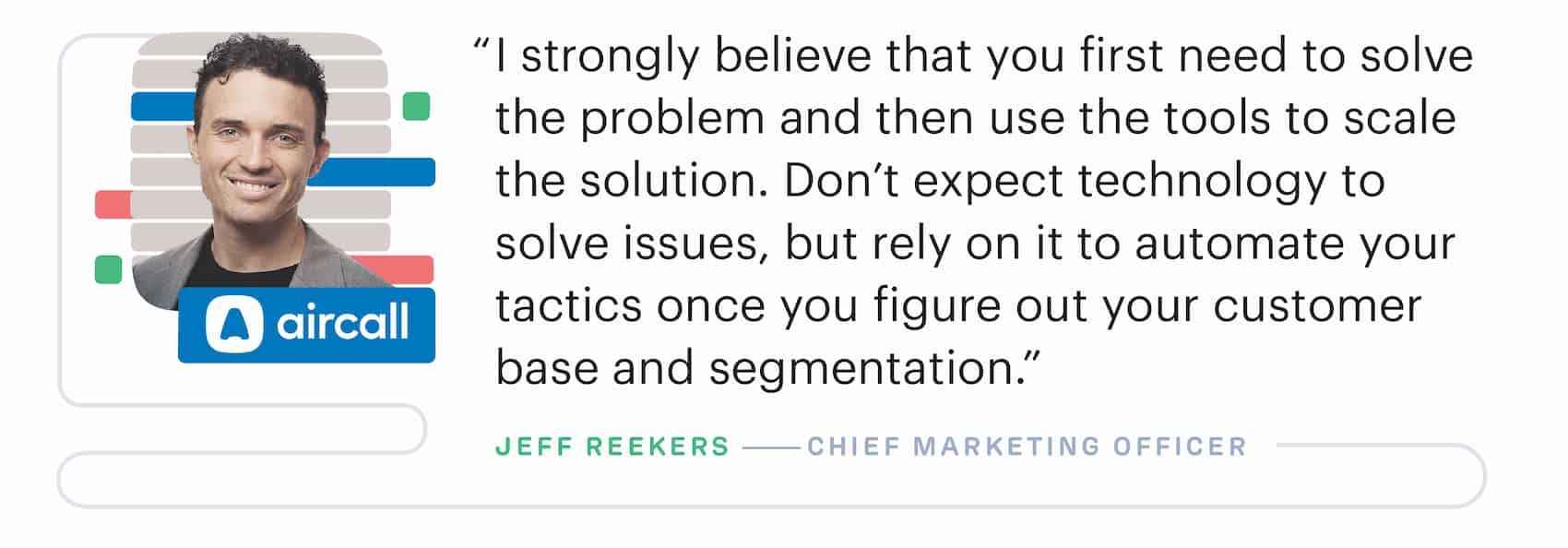 This laissez-faire approach to choosing software can create a bloated marketing technology stack that slows down overall marketing operations and negatively impacts return on investment (ROI) – while also reflecting poorly on marketing leadership. Marketing leaders understand the importance of strategically auditing their martech stack to enhance their technology portfolio’s efficacy and ensure alignment with their company roadmap.
This laissez-faire approach to choosing software can create a bloated marketing technology stack that slows down overall marketing operations and negatively impacts return on investment (ROI) – while also reflecting poorly on marketing leadership. Marketing leaders understand the importance of strategically auditing their martech stack to enhance their technology portfolio’s efficacy and ensure alignment with their company roadmap. Liam Boogar-Azoulay, the former Head of Marketing at MadKudu put it perfectly when he said, “Instead of ripping up a foundation it’s better to build something on top of it – a better roof, a better floor.” Optimizing your martech stack shouldn’t be a hastily executed rip and replace activity, it should be guided by your marketing strategy so it’s designed for success.
Liam Boogar-Azoulay, the former Head of Marketing at MadKudu put it perfectly when he said, “Instead of ripping up a foundation it’s better to build something on top of it – a better roof, a better floor.” Optimizing your martech stack shouldn’t be a hastily executed rip and replace activity, it should be guided by your marketing strategy so it’s designed for success.
#2. The rise of flexible platform ecosystems
This approach to consolidating and optimizing your marketing technology stack echoes Scott Brinker’s observations that flexible platform ecosystems have solved the “suite vs. best-of-breed” dilemma that marketing leaders had previously faced.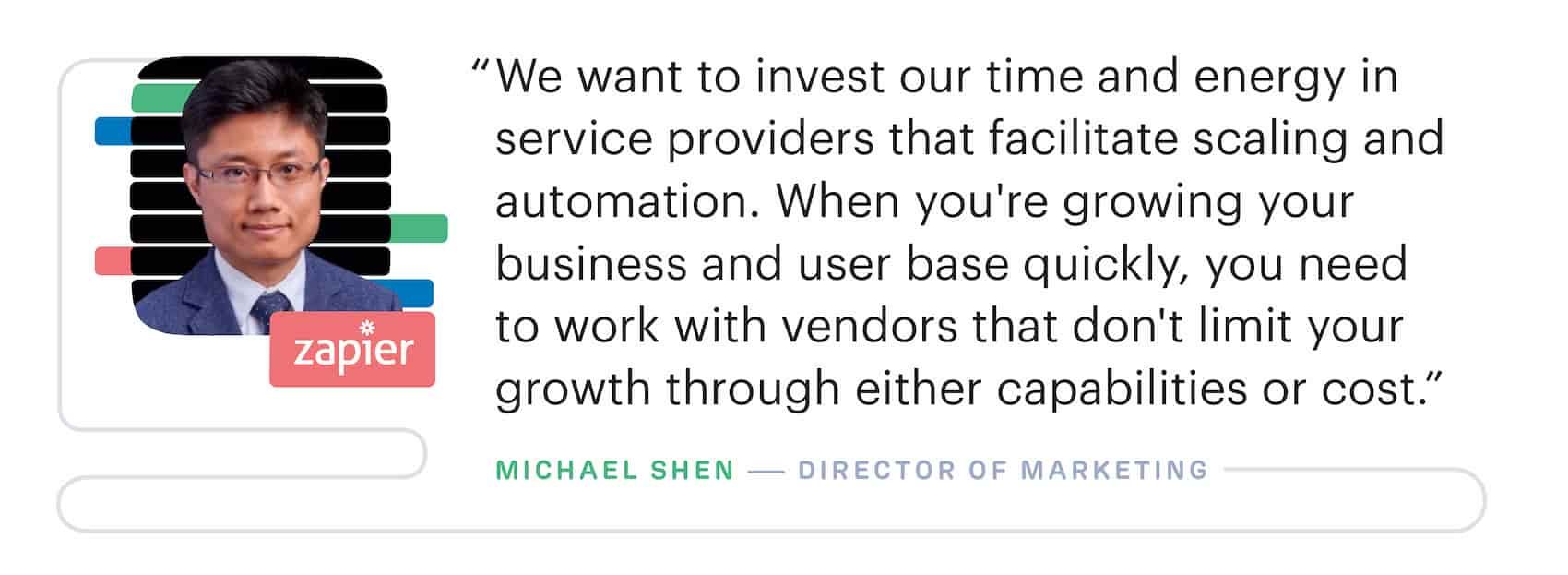 This year, businesses want to enhance their platform ecosystem with tools that play nicely together, enable frictionless collaboration for cross-functional teams, and increase the agility of their marketing operations to surface opportunities faster. With a smorgasbord of customizable and specialist API-first solutions at your fingertips, you need to cast a discerning eye over potential tools and not lose sight of the “who” and “why” of your martech stack.
This year, businesses want to enhance their platform ecosystem with tools that play nicely together, enable frictionless collaboration for cross-functional teams, and increase the agility of their marketing operations to surface opportunities faster. With a smorgasbord of customizable and specialist API-first solutions at your fingertips, you need to cast a discerning eye over potential tools and not lose sight of the “who” and “why” of your martech stack.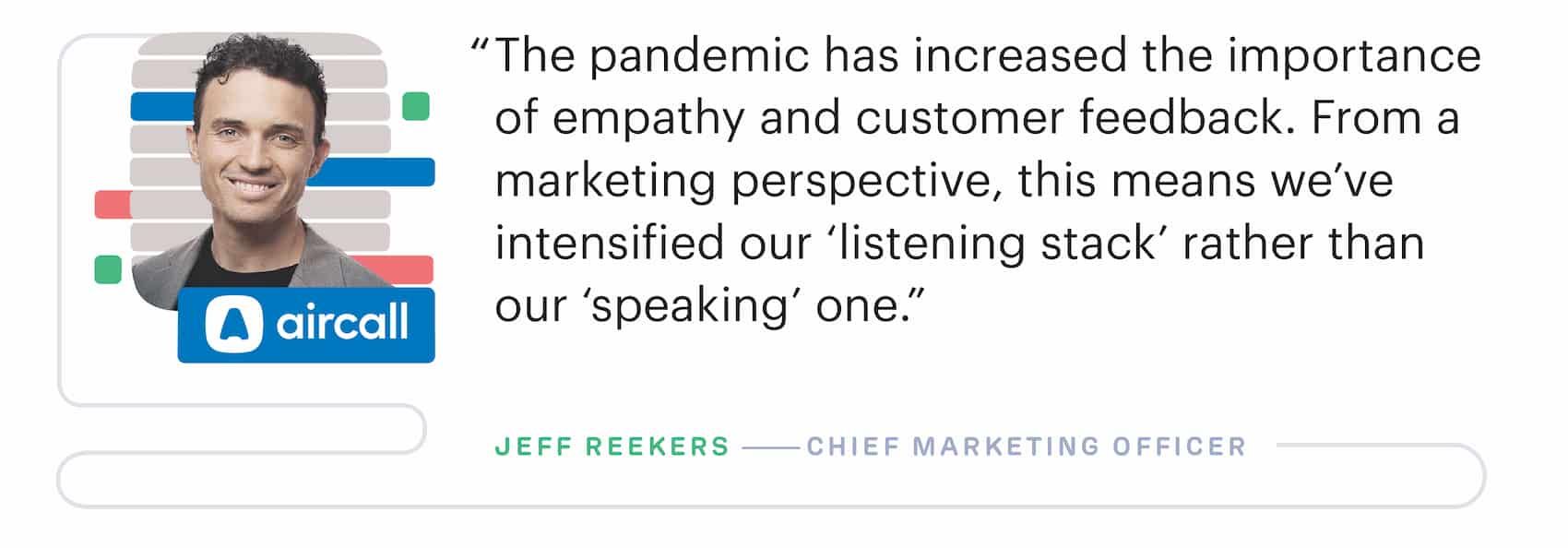 And, of course, APIs remain top-of-mind for marketers, fuelling the free-flowing exchange of data between tools, systems, and channels – affording companies the flexibility they need to meet and exceed customer expectations at scale.
And, of course, APIs remain top-of-mind for marketers, fuelling the free-flowing exchange of data between tools, systems, and channels – affording companies the flexibility they need to meet and exceed customer expectations at scale.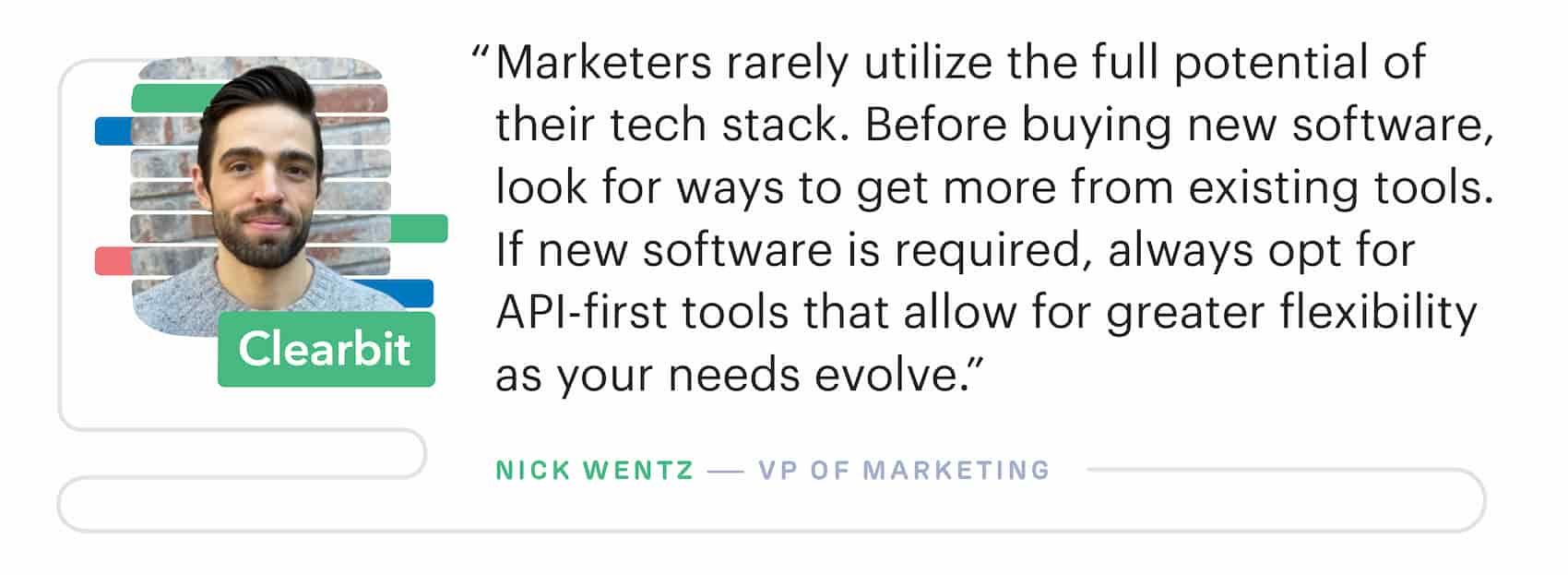
#3. Leveraging data to power automation and personalization
At Intercom, our mission is to make internet business personal. We’re not the only ones who understand the power of personalization this year and beyond.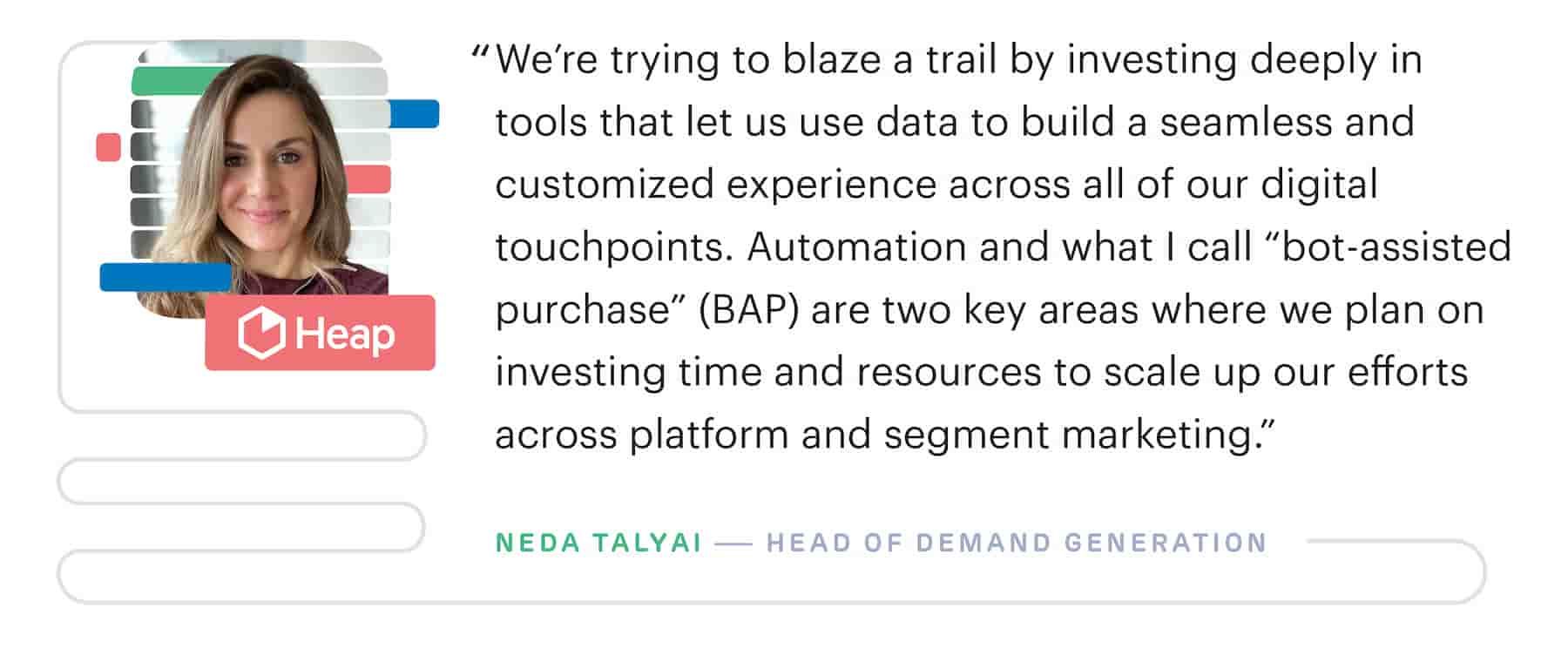 Many of the marketing leaders we spoke with are focused on creating seamless, personalized experiences for their website visitors and customers.
Many of the marketing leaders we spoke with are focused on creating seamless, personalized experiences for their website visitors and customers.
 They plan to leverage data-rich tools to understand the customer and their journey better, to deliver more tailored content and experiences to the right customers, at the right time – using the right martech stack.
They plan to leverage data-rich tools to understand the customer and their journey better, to deliver more tailored content and experiences to the right customers, at the right time – using the right martech stack.
 It’s clear that the pandemic has permanently changed consumer behaviour, and automation has become an essential component for supporting customers and companies alike. Companies plan on refining their automation with data to increase the relevancy of their self-serve, proactive, and human support for customers at every stage of their journey.
It’s clear that the pandemic has permanently changed consumer behaviour, and automation has become an essential component for supporting customers and companies alike. Companies plan on refining their automation with data to increase the relevancy of their self-serve, proactive, and human support for customers at every stage of their journey.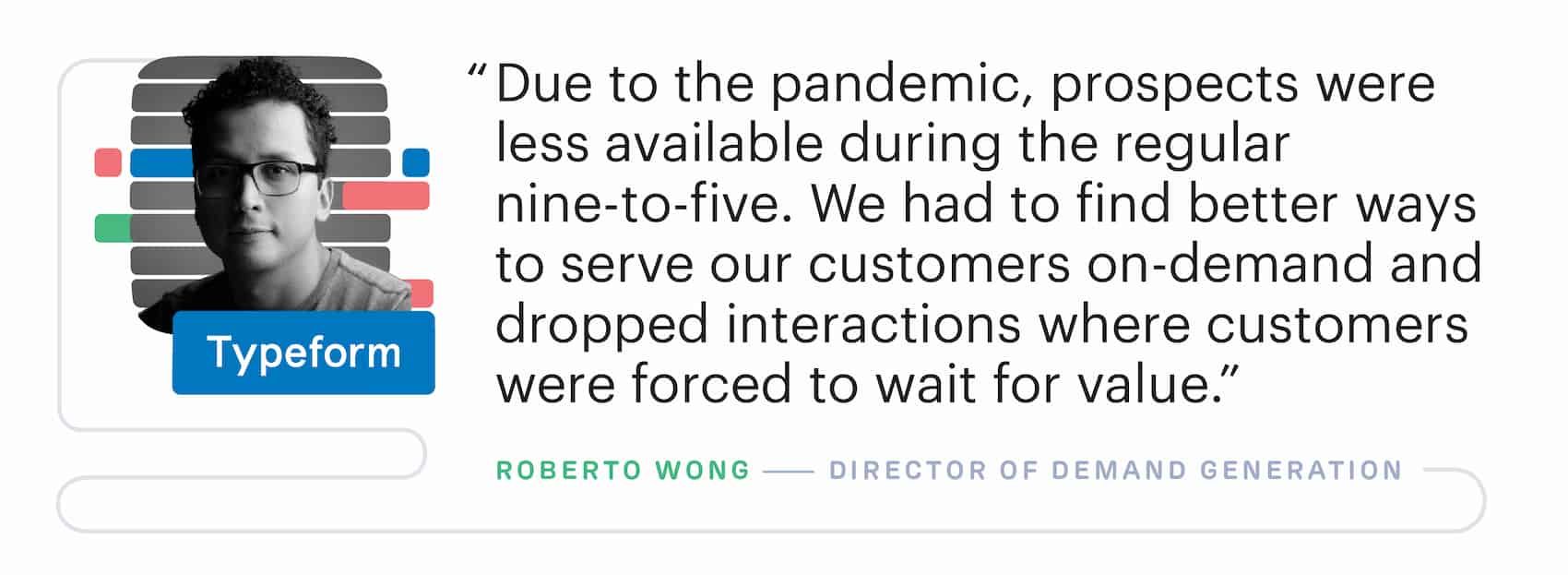
Strategy first, technology second
Technology is not a silver bullet. When preparing for any technology implementation, your first step is probably to head straight to Google or G2, compare feature sets and pricing, and maybe kick the tires with a free trial to see if it’s a good fit. In fact, today’s B2B buyers spend more time researching before buying products, and most of that time is spent on independent research. Only 17% of the time spent researching B2B products is dedicated to talking to sales reps. At the same time, 77% of buyers believe that purchasing has become much more complex.
But here’s the thing: a tool is not a strategy. Sure, you can compare different software packages by their features, but that’s like marrying someone based on their dating profile. The real value marketing software offers is in the strategy and approach it enables — and how it impacts customer experience (the desired end result).
Before you start building (or updating) your marketing technology stack, it’s crucial to devise your marketing strategy. This approach must be shaped around your product, your desired audience, and how to reach them. You’ll have to carefully analyze your current marketing practices and identify where they match the strategy and where they block it. Find out where you lack processes and where you need to do things differently, and choose technology based on that. Once you’ve mapped out these processes, you’ll have a better understanding of the required tools you need for your business – and how they might interact with your existing systems.
Find out where you lack processes and where you need to do things differently, and choose technology based on that. Once you’ve mapped out these processes, you’ll have a better understanding of the required tools you need for your business – and how they might interact with your existing systems.
To summarize: creating a great martech stack is all about devising the strategy that is right for your business, and only then identifying the technology that will help you execute on that strategy. Thinking about it the other way around – trying to improvise a strategy that fits the technology you want to use – simply won’t work.
The anatomy of a martech stack [with recommended tools]
In an ideal world, we’d be able to give you a one-size-fits-all martech stack that could work for any business. But the reality is that your business is unique, and how you operate will impact which technologies you might find important, and how they should be organized. For example, a business that sells their products or services to consumers (B2C) or to businesses (B2B) will use different channels and techniques to acquire customers, and will have varying marketing technology needs as a result.
That said, there are some technologies you should consider as foundational to your marketing technology stack as you begin to build it. These work as well for a B2B company like Intercom as they do for any B2C company, like a retailer or streaming service.
We’ll start by breaking your marketing stack down into three key stages:
- Stage 1: Attract
- Stage 2: Engage
- Stage 3: Analyze and optimize
While there are multiple sub-phases within the above, we’ve chosen the three most common phases almost every business can relate to.
Whether you’re a B2B or B2C marketer, one thing’s for sure: you’ve probably struggled with lead generation. Both landscapes are increasingly competitive and it’s little wonder that 61% of marketers rate lead generation as one of their biggest challenges.
But lead generation starts with traffic and this is what our first collection of marketing technology tools will be taking care of.
Google Ads – ad tech
When it comes to driving qualified traffic to your site, Google’s search, video, and display ads are still the fastest way to get results. Not only are you targeting people who show a specific interest in what you’re selling, Google’s ads act as a first point of contact for lead nurturing tactics like remarketing, email marketing, and conversion optimization.
Alternatives: AdRoll, Quantcast, Basis
Demandbase – ad tech
Account-based marketing (ABM) has evolved from a buzzword to a “must-have” for marketing teams today. Up to 91% of B2B marketers report bigger deal sizes with ABM, and despite the constraints brought by the pandemic, most B2B marketers stated they would either maintain or increase their ABM budgets.
Demandbase enables companies to deliver personalized online ads to specific people at specific companies across the web while refining the message to try to convert them into customers. So let’s say Joe works for Pfizer. By using Demandbase for digital marketing, Joe will be served personalized ads for healthcare offerings, using predetermined criteria, such as revenue, industry, and previous purchasing habits. Pretty neat, huh?
Alternatives: Terminus, RollWorks
Unbounce – landing page builder
What’s the point of spending hours creating targeted ads only to send prospects to a generic, soulless landing page? This is one of the fastest ways to lose potential leads and sales opportunities.
“Unbounce lets you quickly and easily create beautiful custom landing pages that convert more website visitors into customers”
The good news is that Unbounce lets you quickly and easily create beautiful custom landing pages that convert more website visitors into customers. You can create and publish a landing page in minutes – with no code required! Their powerful A/B testing functionality also allows you to experiment with your messaging, design, and forms to understand what makes visitors convert more often.
Intercom integration ✅
Alternative: Instapage, GetResponse, Knak
Sprout Social – social media management
Sprout Social allows you to manage your entire social media strategy from one place. In fact, it’s how we attract and engage with hundreds of thousands of customers and prospects at Intercom. With Sprout Social, you can schedule posts at optimal times, streamline your publishing workflows, and turn social data into meaningful insights. All of this is geared towards helping you optimize your social media strategy and better connect with your audience. That’s a win-win in our books.
Intercom integration ✅
Alternatives: Buffer, Sprinklr, Hootsuite, MeetEdgar, Later
WordPress – CMS
Intercom’s blog is the growth engine that powers much of Intercom’s marketing, and it in turn is powered by WordPress. In fact, WordPress is the content management system (CMS) powering over 43% of all the websites on the Internet. Yes – more than one in four websites that you visit are likely powered by WordPress.
“WordPress makes building a website accessible to anyone – even people who aren’t developers”
WordPress lets users build everything from blogs to full-blown websites with hundreds of themes to choose from. Better yet, WordPress makes building a website accessible to anyone – even people who aren’t developers.
Intercom integration ✅
Alternatives: Ghost, Medium, Drupal, Squarespace
Ahrefs – SEO
Want to drive boat loads of organic traffic to your website? Here’s a tried and tested formula:
- Pick a topic or keyword
- Create an exceptional piece of content around that topic
- Promote it. Build links to it. Rank it.
It is a simple formula, but only if you use the right tools for the job. Ahrefs is a suite of SEO tools that helps websites, blogs, and companies grow their search traffic, do in-depth research on their competitors, and monitor their niche. Which keywords and topics should you be trying to rank for? How many links do you need to build to rank for your chosen keywords? Ahrefs lets you figure out all that and more.
Alternatives: SEMrush, Moz, Conductor, Siteimprove
Zoom – webinars
One-on-one meetings and conference calls are Zoom’s bread and butter, but it’s also a damn fine tool for hosting webinars that can drive people to your website.
“We’ve held close to 100 webinars with Zoom and the user experience for the business and for participants is next level”
We’ve held close to 100 webinars with Zoom and the user experience for the business (it hooks into your CRM very nicely) and for participants (the video quality is unparalleled) is next level. Bonus: You can now enable visitors and users to register for webinars directly in the Intercom Messenger with our Zoom integration.
Intercom integration ✅
Alternatives: GoToMeeting, WebEx, Blue Jeans
Wistia – video marketing
Today’s video marketing efforts live primarily on YouTube – but is that really the most effective channel for reaching your audience? Not always. For B2B marketers like ourselves, Wistia takes everything a step further and helps you drive traffic to your website, increase engagement, and improve your website’s conversions.
At Intercom, Wistia allows us to manage and update existing videos as our product and marketing evolves, without changing URLs or losing historic engagement data and those invaluable customer insights. The added bonus? Since you can host your video on your website, all the traffic goodness and engagement goes to your domain instead of YouTube.
Intercom integration ✅
Alternatives: Vidyard, Vimeo
Uberflip – content marketing
So much of your marketing team’s efforts goes into creating content that’s relevant to your target audiences, but what does it matter if you can’t get that content in front of the right people at the right time?
As a content experience platform, Uberflip lets you pull all your content – from newsletters to blog posts and videos – into one place. Then, you can build content hubs that are organized by topic or category, helping buyers find the content or answers they’re looking for. Top of the list for the benefits of this tool is that prospects can access relevant content faster, which makes them more likely to turn into qualified, informed leads.
Intercom integration ✅
Alternatives: Outgrow, Ion
MadKudu – lead scoring
Marketing teams aren’t just responsible for filling the sales pipeline with quantity. They’re responsible for filling the sales pipeline with quality too. There is little point in attracting thousands of leads who would never be a good fit in the first place. Lead scoring is one of the best ways of guaranteeing the leads you hand over to sales are of a certain quality.
MadKudu is one of the most powerful lead scoring tools on the market and can help calculate tons of valuable information, most of which is not visible to your sales team. Beyond job title and employee count, MadKudu can evaluate the predicted revenue of each company, the size of specific teams, the tech stack and tools that a company uses, whether their solution is B2B or B2C, whether it has a free trial or not, whether they’ve raised venture capital, and much more – meaning your sales team can hone in on leads who show the best determiners of success.
Intercom integration ✅
Alternatives: Salespanel, Infer, ActiveCampaign
In 2022, US marketers are expected to spend $12.65 billion attracting businesses to their websites, a 17% increase on 2021 projections.
Isn’t it amazing how much attention (and cash) we pay to the campaigns which drive traffic to our websites, but in comparison how little we think about what happens once a prospect lands there?
“The fact is, buyers today have all the power – they don’t want to have to fill out forms and wait for lengthy follow-ups”
Usually we just select from a list of stock tactics like asking them to fill out a form so they can book a demo or get some cool content. And once we get that email address we add them to an email nurture campaign, even though we all know the messages are going to end up buried behind Gmail’s Promotions tab.
The fact is, buyers today have all the power. They don’t want to have to fill out forms and wait for lengthy follow-ups. Customer expectations are at an all-time high, and marketers need to find a way to meet and exceed these demands. For that, we’ve put together a collection of tools that will help you engage your website visitors in a modern way.
Intercom – customer engagement and lead generation
Obviously we’re biased (though we would point you to the reviews on G2 Crowd to show that we’re not that biased) but Intercom’s customer communications platform is the backbone of our martech stack, providing end-to-end engagement throughout the entire customer journey.
We use it for:
- Sending targeted messages to visitors on our website.
- Building chatbots to automatically engage and qualify leads 24/7 on our website.
- Tracking and monitoring customer data so we can better understand our audience and properly serve them with the right content and messages.
Additionally, Intercom solves one of the biggest headaches when it comes to constructing your martech stack – integrations. Even if a platform promises great results, it will do more harm than good if it doesn’t integrate with the rest of your tools. For example, if your live chat tool doesn’t integrate with your CRM and requires four different people to move leads from one system to another, you’ve got a problem.
“Intercom solves one of the biggest headaches when it comes to constructing your tech stack – integrations”
Intercom has over 275 integrations with the likes of Google Analytics, Salesforce, HubSpot and many more so you can rest easy that everything will play nicely together.
Alternatives: None 😉
Clearbit – data enrichment
For many companies, over 90% of their web traffic is anonymous. At Intercom, we use Clearbit Reveal to help de-anonymize website traffic.
When a prospect visits the Intercom website, Clearbit uses their IP address to detect their company, its industry, its location, what technology the company already uses, and more. This means you can customize your communication to each individual and avoid those spray-and-pray tactics from years gone by.
To give you one example: let’s say your sweet spot is B2B SaaS companies. By using Clearbit Reveal in tandem with a messaging tool like Intercom, you can have a personalized message that shows up when someone from a B2B SaaS company hits your website (and conversely doesn’t appear for a B2C company who you believe aren’t a great fit).
Intercom integration ✅
Alternatives: ZoomInfo, LinkedIn Sales Navigator, Cognism
Marketo – marketing automation
Marketo is one of the most poweful marketing technology tools on the market. There’s a very good reason it was named the second most popular product in B2B stacks in 2021 (just behind Google Analytics, in case you were wondering).
“Marketo allows users to automate their marketing processes by creating personalized campaigns that scale, identifying top prospects, and finding and connecting with the right customers”
Marketo allows users to automate their marketing processes by creating personalized campaigns that scale, identifying top prospects, and finding and connecting with the right customers. It’s probably overkill for a smaller business, but if you’re moving from startup to scale-up, Marketo is perfect for those looking to grow and market to a large audience with a high degree of segmentation.
Intercom integration ✅
Alternatives: Pardot, Eloqua
HubSpot – marketing automation
Like Marketo, HubSpot is now a household name (if your house is full of marketers). The breadth of its platform is pretty breathtaking, with products that run the gamut from advertising, blogging, SEO, email, social media, call-to-actions and beyond. As a low-cost (and in some cases free) platform, it’s particularly popular with small businesses who can’t afford the wealth of best-of-breed software options that more mature companies can.
There’s now an app that integrates Intercom with HubSpot, making it easy to sync your data between both products. This means less time wasted copying and pasting between tools and less lost marketing opportunities.
Intercom integration ✅
Alternatives: Marketo, Pardot
Dotdigital – marketing automation
Connecting with customers is more important than ever – luckily it’s also easier than ever with Dotdigital’s cross-channel marketing platform. With their data-driven services, you can personalize at every touchpoint, all while gaining important insights.
Their integrated tools include:
- Email marketing
- SMS marketing
- Landing pages & forms
- Social & search retargeting
- Live chat
All to assist you with deepening customer relationships and growing your business. They’re just as dedicated to your success as they are to digital marketing – with a fast onboarding process, plenty of resources and guides, and ongoing support.
Intercom integration ✅
Alternatives: Marketo Engage and HubSpot
ActiveCampaign – customer experience automation
Typically, it takes eight touchpoints to move a lead from their first impression of the brand to a sale. For teams that don’t have a lot of resources on their sales or marketing teams, that’s a big investment that doesn’t always pay off. Plus, with the silos that typically exist between those two teams, it can be hard to determine who’s responsible for which part of the conversation.
One solution? Automation.
As an extensive customer experience automation platform, ActiveCampaign lets you automate your follow-up and outreach strategy, giving you the opportunity to personalize each of the eight touchpoints that drive conversions. Focused primarily on email, it gives marketers the ability to create drip campaigns and split testing, encouraging better open rates and engagement from their audience.
Intercom integration ✅
Alternatives: Keap, Constant Contact
Encharge – CMS and email journeys
We talked about personalization being a key driver in customer expectations, and that’s why we’ve included Encharge in this list. Using descriptive and behavioral data from your customers, Encharge creates personalized email journeys that align with different segments.
From a pricing standpoint, Encharge is ideal for companies that are still scaling and haven’t quite reached the point where they need a robust email marketing automation platform. It integrates seamlessly with customer data systems like Segment and Mixpanel (more on them below) to create hyper-customized communications that speak to customers in a more direct way. Plus, the platform has added features including lead qualification support.
Intercom integration ✅
Alternatives: MailChimp, Omnisend
Knak – no-code email design
Knak is on a mission to make life easier for marketers, and who can argue with that? Their no-code approach to email and landing page creation puts creativity back in the hands of enterprise marketers, who up until now have had to rely on developers and agencies to get their emails out the door.
With Knak, marketers can significantly cut down their email production time, making it easier to respond to timely trends, events or news items – and build trust with their audience as a result. Plus, for teams that are still building up their marketing budget, they have a collection of free email templates that are accessible to anyone.
Alternatives: Stensul, Moosend
Outreach – sales engagement
Marketing teams have always been great at generating and nurturing leads. But they haven’t been so good at handing those leads over to sales and making sure they’re acted on. In fact, most marketing teams often have little insight into whether or not reps have actually advanced inbound leads or not.
Outreach is the kind of tool for teams who are serious about sales and marketing alignment. It tracks your reps’ interactions with prospects and customers and recommends prescribed sequences of communications based on that. Better yet, instead of marketing logging into one system, and sales into another, both teams can use Outreach dashboards and tools, making sure no lead falls through the cracks.
Intercom integration ✅
Alternatives: SalesLoft
Aircall – cloud calling
Every marketer knows that if they were given five minutes to show all new users their product and answer their questions, they’d nail their monthly recurring revenue targets. The problem is that setting up lots of screen shares each day is a teeth-grinding process.
Aircall lets you start a phone call instantly from pretty much every major software system out there like Intercom, Slack, HubSpot and more. Getting visitors from chat into a face-to-face demo can all be arranged automatically in a matter of minutes to dramatically speed up the sales cycle.
Intercom integration ✅
Alternatives: Dialpad, Talkdesk
Arthur Nielsen, the pioneer of data-driven marketing, used to say that “the price of light is less than the cost of darkness.” The point is elegantly made – it’s not a question of whether you can afford to invest in analytics, it’s a question of whether you can afford not to. Unfortunately, all too often that truth is only considered after the fact, with analytics tools bolted on to a martech stack afterwards rather than informing the marketing technology system as it is being built.
“Of course, half the challenge for marketers today is choosing which of the thousands of data sources to integrate into their marketing system”
Despite budget cuts, harnessing the power of marketing analytics to refine the customer experience remains a top priority for marketers in the marketing technology landscape and many of the marketers we spoke with plan to embrace the validation capabilities of analytics at every layer of their martech stack.
Of course, half the challenge for marketers today is choosing which of the thousands of data sources to integrate into their marketing system. Not to worry. We’ve chosen a handful of tools that can be threaded throughout your martech stack to help give you a 360-degree view of your marketing effectiveness.
Google Analytics – web analytics
The reliable workhorse of the marketing technology stack. So reliable in fact that recent estimates for the number of companies using Google Analytics range anywhere from 30 to 57 million. 😱
Sure, the user interface (UI) is not the prettiest and we often find ourselves several menus deep, caught up in a perplexing mess of filters and date ranges. But it is a truth universally acknowledged that Google Analytics is brilliant for four reasons:
- Knowing where your website visitors are coming from
- How they found you
- What content they viewed
- How long they stayed on parts of your site
All this provides infinite insight into your buyer personas and countless data-backed optimization opportunities.
Combine this with a customer communications platform like Intercom to track visitor interactions with your Messenger all the way through the funnel and you are in prime position to take your marketing effectiveness to the next level. And who doesn’t want that?
Intercom integration ✅
Alternatives: Firebase, Heap
Tableau – business intelligence
Business intelligence (BI) software is an increasingly powerful tool in a marketing team’s arsenal, allowing teams to track every dollar and every movement throughout the marketing funnel. The real power comes in connecting multiple data sources to gain invaluable insights otherwise lost. Let’s take an AdWords campaign for example. You could look at your AdWords dashboard within your account, but with a BI solution, you could look at AdWords, marketing automation, and CRM data in one visualization to get a complete view of your marketing efforts.
Tableau is recognized as the cream of the crop for its visual-based data analysis. Its data visualization is head and shoulders above what traditional BI vendors offer. You can perform fairly complex data visualization in a very intuitive, drag and drop manner so your team doesn’t waste time fiddling around with SQL.
Intercom integration ✅
Alternatives: Microsoft BI, Looker, Domo
LeanData – lead management
Conversions aren’t a nice, neat and organized path from point A to B. No, the conversion process is often more like a winding road of tangents, intersections and loops that involve a whole host of marketing touchpoints. In order to understand the real ROI of your marketing program, you need to know which individual components really moved the needle. Without these, it’s all too easy for marketers to invest in under-performing marketing channels that yield poor pipeline and revenue.
“Different marketing attribution models may suit different business needs depending on the length and complexity of the buyer’s journey”
LeanData connects with your CRM tool to provide the most accurate, channel-by-channel view of campaign performance so that your team can choose how to spend money in the most effective ways possible. Different marketing attribution models may suit different business needs depending on the length and complexity of the buyer’s journey so LeanData features fully-customizable attribution models that can be finely tuned to your business.
Alternatives: Bizible, Terminus
Segment – customer data infrastructure
Businesses today have data coming at them from a myriad of locations. Extracting that data from the various silos within which it sits, and then transforming it in such a way that it can be rendered useful, is hugely complex. Anything that can automate the collection and transformation of that data is a good thing for your business.
This is where Segment comes in. It gathers together all the data about a customer from a variety of sources – like your CRM tool, customer service application, and website and pulls that all together into a single view of the customer, something that is the goal of every company in the customer information business. Think of it as a data hub for your entire company. As companies employ a broader arsenal of marketing and analytics products, consolidation tools like Segment are only going to become more and more popular.
Intercom integration ✅
Alternatives: Tealium, mParticle
Heap – product analytics
Heap is a powerful analytics tool that uses behavioral analytics to contextualize user actions and empower teams to make smarter decisions. The beauty of this software lies in its simple no-code setup – perfect for busy marketers. In minutes, you can start to collect the metrics that matter most for your company without getting into the weeds of event tracking code.
“Heap provides granular data to create a holistic overview of your customers, their behaviors, and their needs”
With automatic data capture, event tracking, comprehensive individual user history, and retroactive data analysis to inform ever-evolving deliverables, Heap provides granular data to create a holistic overview of your customers, their behaviors, and their needs.
Intercom integration ✅
Alternatives: Google Analytics, Adobe Analytics
Hotjar – conversion rate optimization
It’s not easy finding an analytics tool that captures who your visitors are, and combines that with what your visitors are doing on your website. Hotjar combines a range of essential analytics features (conversion funnel analysis) with user feedback tools (screen recordings, surveys, and so on) into a single platform.
Probably one of the most-used tools that Hotjar has to offer is their Heatmaps offering, which visually represents your visitors’ clicks, taps, and scrolling behavior. It’s perfect for understanding what areas of your website people are spending time on.
Alternatives: Crazy Egg, FullStory, Quantum Metric
Optimizely – conversion rate optimization
There’s a famous anecdote from Marissa Mayer’s time at Google, referred to as the “Forty Shades of Blue” episode. She ordered that 40 different shades of blue would be randomly shown to each 2.5% of visitors; Google would note which color earned more clicks. The best performing shade led to $200M in revenue a year.
We’re not all lucky enough to have enough design and engineering resources to embark on a test like this (let alone enough traffic to test such a hypothesis) but the wider point should not be missed – optimization and experimentation needs to be a key part of any marketing strategy.
Optimizely allows you to create variations of your existing website with A/B, multi-page, or multivariate tests, and then tracks how customers respond to those different versions. The best part is that it’s absurdly easy to use. You don’t have to code anything to adjust your website with this tool. Optimizely has a visual editor, which allows you to make changes by clicking instead of coding, perfect if you don’t have a full time development team at your disposal.
Alternatives: Unbounce, Instapage
Winning martech stacks
As soon as we started putting together our ideal marketing tech stack, we had an idea:
Let’s grab our magnifying glass and analyze what tools our peers in the industry are using, day-to-day.
From what live chat software they’re using to engage their visitors, to how they’re measuring success, we partnered with three leading companies to get a behind-the-scenes look at how the world’s top marketing teams operate.
HubSpot
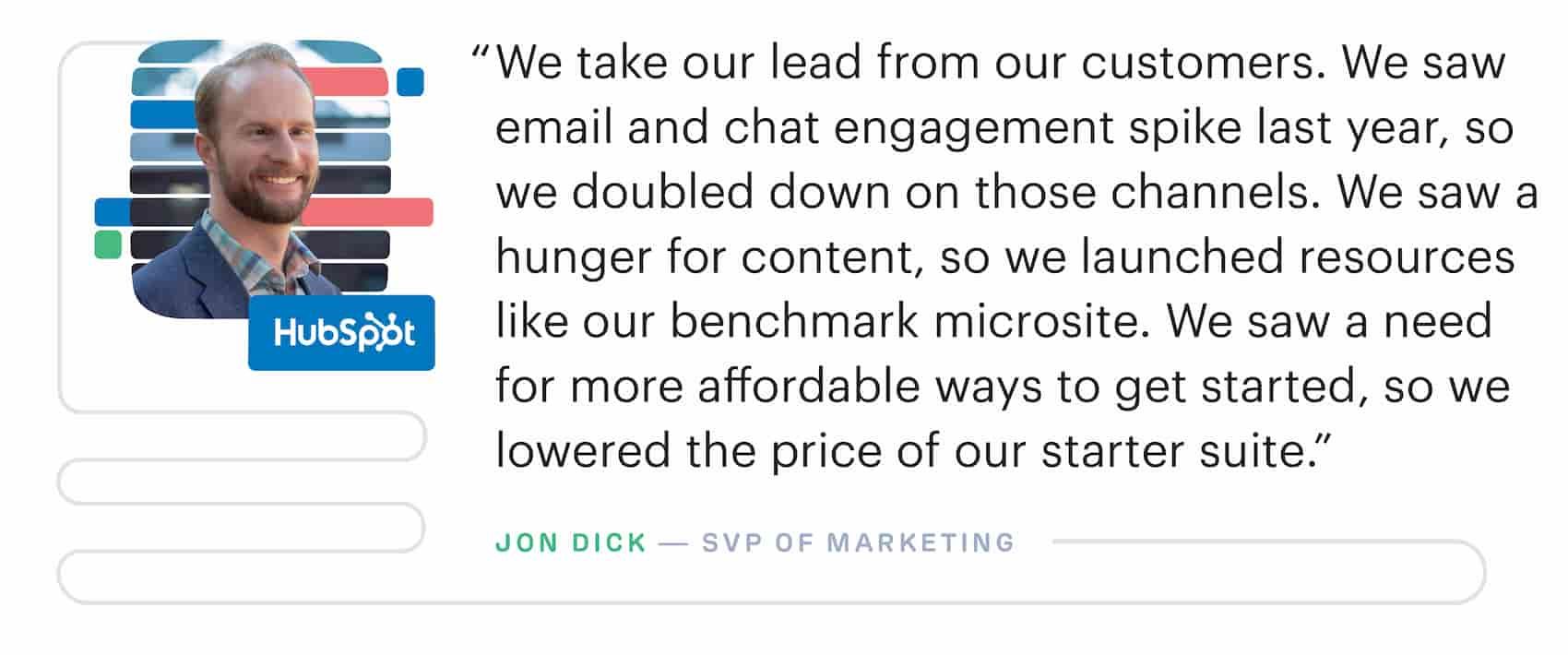 As we mentioned above, HubSpot is now a household name. Its platform helps marketers to centralize their advertising, blogging, SEO, email, social media, call-to-actions and more. It’s particularly popular with small businesses as a robust affordable solution, but is flexible enough to scale with a business as it grows.
As we mentioned above, HubSpot is now a household name. Its platform helps marketers to centralize their advertising, blogging, SEO, email, social media, call-to-actions and more. It’s particularly popular with small businesses as a robust affordable solution, but is flexible enough to scale with a business as it grows.
HubSpot is focused on leveraging their CRM platform for their CMS, Marketing, Sales, and Service use cases and integrating partner apps to support additional use cases. Jon Dick, SVP of Marketing at Hubspot says that “Creating a customer experience is complex. Gaining a unified view of the customer is critical. So, don’t cobble your stack together.”
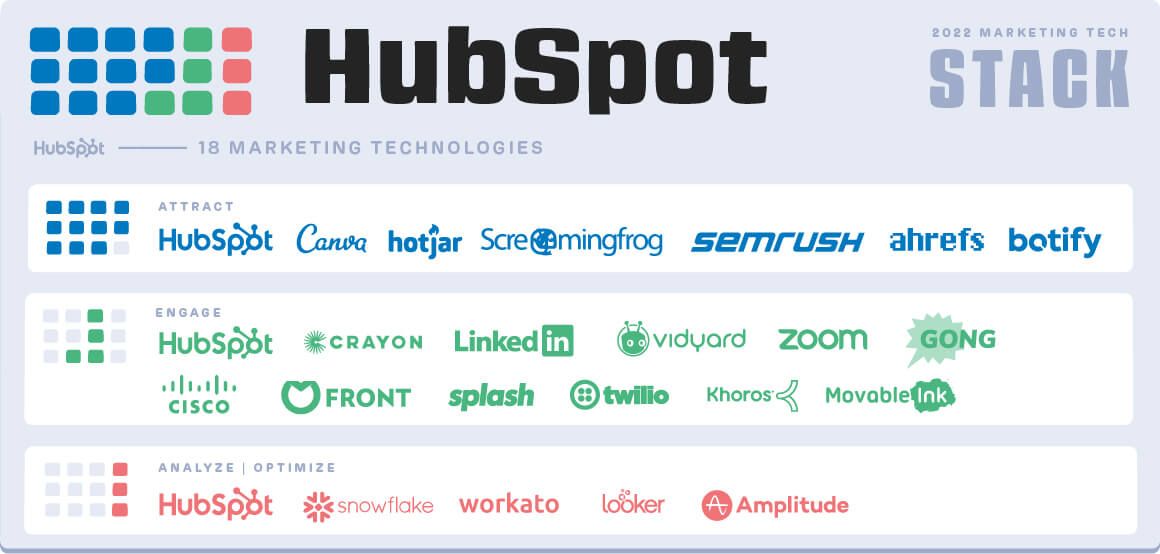
Clearbit
Clearbit gives companies a deeper understanding of their customers. This powerful data-enrichment tool helps businesses to provide highly personalized experiences for prospects on an individual level, so they can close on quality leads.
This year, Clearbit is focused on optimizing their existing stack to leverage the full capabilities of their current technology while making strategic investments in software that supports further personalization across the customer journey.

Heap 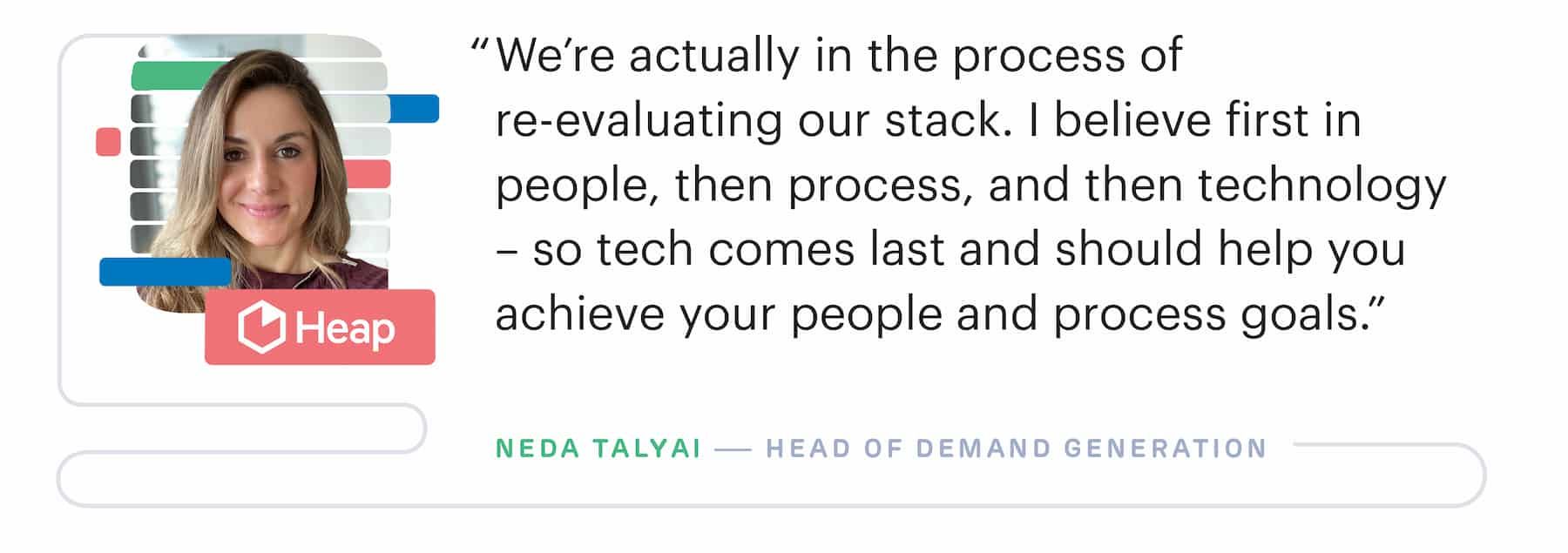
Heap allows teams to create digital experiences that convert and retain users. Their software empowers product, marketing, and customer success teams to understand their users’ behaviors so they can provide a frictionless experience.
This year, Heap is focused on re-evaluating their marketing technology stack to ensure it’s streamlined for better collaboration and internal workflows. Personalization remains front-of-mind for them, and they’ll be using data to inform and refine their sales prospecting processes.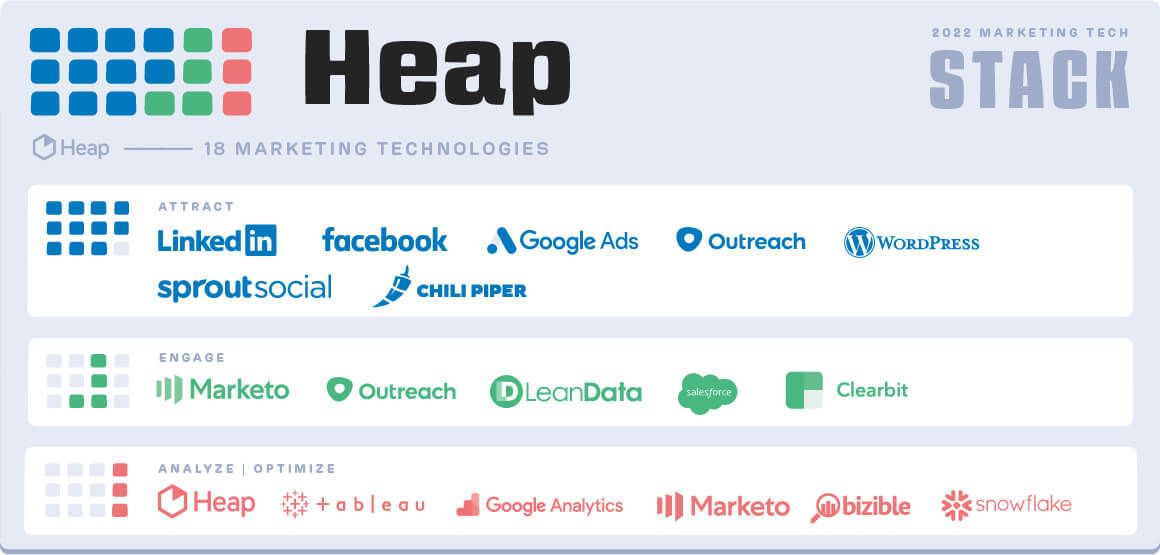
Bonus: the marketing tech stack that has helped us grow Intercom from 0 to 25,000+ paying customers
In just over four years, Intercom’s marketing team has grown from one person to well over 70. It follows that the software we use has evolved significantly since then. What was once a basic setup of WordPress and Google Analytics has evolved into a sophisticated stack of over a dozen tools.
As the team and tools have grown, one thing has remained constant: Intercom. It’s the beating heart of our marketing stack and it powers our conversational marketing strategy, allowing us to engage prospects and customers alike at every stage of their journey. From product announcements, nurture campaigns, marketing automation, lead capture, lead qualification, booking meetings – you name it, we probably use Intercom for it. The philosophy of our stack is to use Intercom as our default, and then to complement when the need arises.

No software is an island – the need to connect tools and teams in your martech stack
What all of these marketing tech stacks point to is a shift in the way businesses are capturing, qualifying, and connecting with their leads and customers. As businesses move toward creating more personalized, cohesive, and data-driven experiences for their customers, they need increasingly connected tools.
The tide is changing from software islands to platform ecosystems that empower not just tools, but also teams to play nicely together. Rather than simply growing larger, tech stacks are getting smarter, more streamlined, and ultimately more connected to thrive in the ambiguity of the pandemic and beyond. The silos between sales and marketing tech are quickly eroding. As such, there’s a growing trend for software like Intercom, Outreach, and Clearbit that crosses organizational boundaries to create agile, collaborative teams that can improve customer experience as the year unfolds.
Whatever tools you choose for your marketing stack, just remember that the technology you choose must also connect into your strategy – not the other way around.
Want to build conversational customer engagement into your marketing tech stack? Learn how Intercom can help.
Frequently asked questions about martech stacks









